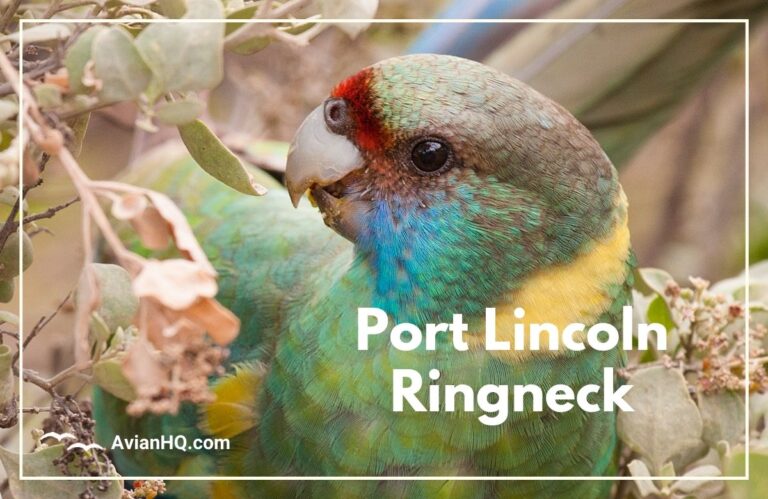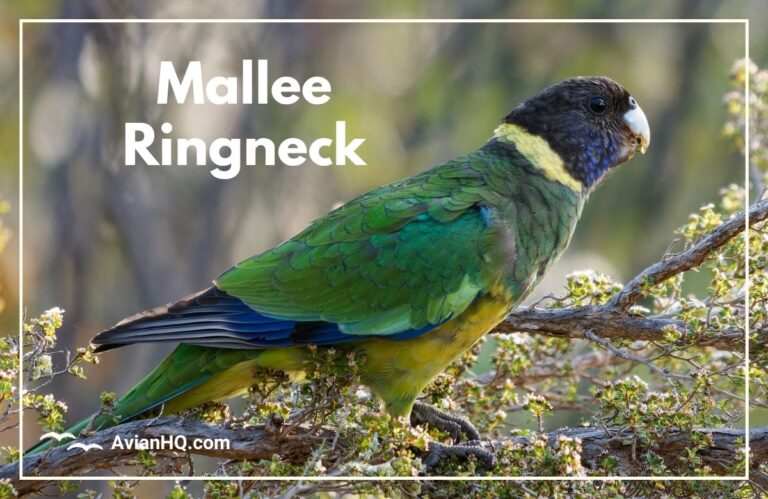Genus: Barnardius
Barnardius is a genus of parrots belonging to the broad Psittacidae family. You can easily recognize members of this genus by their vibrant green and blue plumage, as well as the bright red bands under their tails.
Found across Australia, these charismatic parrots have become cultural icons and favorite pet birds. The genus includes around 9 species, such as the Mallee Ringneck and Port Lincoln Ringneck. They tend to thrive in semi-arid habitats dotted with old growth trees that provide nesting hollows.
“Barnardius parrots are exceptionally playful, social, and quick learners. Their antics and ability to mimic speech make them wonderful companions for the right owners.”
In the wild, Barnardius parrots live together in raucous, large flocks – roosting, foraging, and soaring across open skies in tight synchronized formations. They maintain life-long monogamous bonds and work cooperatively to raise chicks in tree hollow nest sites.
We’ll spotlight key species and discuss why Barnardius parrots have secured a beloved spot in Australian culture. Conservation challenges they face today will also be highlighted. Let’s dive in and explore this colorful genus of feathered friends!
Species Spotlights
The genus Barnardius includes several species of vibrant parrots found across Australia. Here we’ll spotlight two of the most popular species – the Mallee Ringneck and Port Lincoln Ringneck:
Mallee Ringneck (Barnardius barnardi)
The Mallee Ringneck is a small parrot reaching lengths of 11-12 inches (28-30 cm) and weights around 3-4 ounces (85-110 grams). Native to the mallee regions of Australia, these parrots get their name from the bright green rings around their necks.
Male Mallee Ringnecks have vibrant green plumage on their backs and wings, while females show more blue-black feathers. Their bellies are a rich yellow-green hue. These diminutive parrots prefer to stay hidden amongst dense vegetation and only take to open skies when traveling between sites.
“Seeing a flock of Mallee Ringnecks emerge from cover and take off in unison is an incredible sight – they maneuver almost as one!”
Port Lincoln Ringneck (Barnardius zonarius)
Slightly larger than its Mallee cousin, the Port Lincoln Ringneck measures 13-15 inches (33-38 cm) long and weighs 5-6 ounces (140-170 grams). These parrots populate coastal regions near Adelaide, South Australia and have far more yellow plumage than other Barnardius birds. Of course, they still possess the signature green neck rings.
The Port Lincoln Ringneck is highly gregarious and often congregates in large communal roosts after feasting on grain crops. Their loud squawks reveal their presence! You can also distinguish them by their blue-tinted wing feathers and extensive yellow uppertails.
- Key Comparisons
- Mallee Ringneck: Smaller, found inland, mostly green
- Port Lincoln Ringneck: Larger, coastal, more yellow plumage
Let’s take a closer look at why these species exhibit such lively behaviors and intelligence.
Behavior and Intelligence
Barnardius parrots are exceptionally smart and social birds. Their playful antics, ability to mimic speech, and strong bonds with flock mates make them wonderful pets when properly trained.
In the wild, Barnardius parrots live in large, noisy flocks of up to several hundred birds. They roost together at night and forage collectively during daylight hours. You can often spot 50-100 parrots soaring together in tight synchrony across open skies near dawn and dusk.
These parrots communicate constantly using a wide repertoire of squawks, chirps, mimicry, and physical displays like outstretched wings. Their long-term bonds and cooperative behaviors highlight advanced emotional capacities.
“When a flock of Barnardius parrots engages in raucous play sessions while dangling precariously upside down from branches, you can’t help but smile at their audacious antics!”
In captivity, all Barnardius parrots display excellent puzzle-solving skills and capacity for learning words. However, the Port Lincoln Ringneck is often noted as the most adept mimic able to clearly pronounce lengthy phrases. Keepers need to provide lots of toys and social bonding opportunities.
- Key Behaviors
- Exceptionally social and playful
- Communicate with sounds and displays
- Strong ability to mimic human speech
- Solve problems and puzzles in captivity
Seeing such smart creatures face threats in the wild should give us pause. Let’s discuss conservation needs.
Cultural Significance
With their vibrant colors, playful nature, and intelligence, Barnardius parrots have secured a special place in Australian culture. They appear in Aboriginal folk stories, artwork, stamps, state symbols, and more.
Historic records indicate many Aboriginal groups traditionally hunted Barnardius parrots for food and ceremonial garb. Tail and wing feathers were prized for adorning rituals. Some oral traditions involved mystical parrot creatures.
Today, Barnardius parrots remain extremely popular aviary birds and house pets across Australia. However, they require ample space, enrichment, and proper training. Some feral populations now flourish in cities like Adelaide and Perth.
The South Australia government featured the native Port Lincoln Ringneck on local postage stamps in the 1980s. More broadly, parrots generate tourist revenue through birdwatching tours, cultural sites, and wildlife parks.
However, wild Barnardius parrots still face alarming habitat pressures and illegal trapping. It’s important to balance our affection for these birds with responsible stewardship.
- Key Significance
- Feature in Aboriginal myths and rituals
- Popular as pets and aviary birds
- Depicted on stamps and state symbols
- Generate tourism and interest
Conserving vulnerable populations remains an ethical obligation.
Threats and Conservation
While Barnardius parrots remain relatively widespread, some localized populations face concerning declines from habitat loss and trapping.
The main threat across Australia involves destruction of old growth eucalyptus stands. As nesting hollows disappear, the parrots compete more fiercely for remaining sites. Entire breeding communities can collapse if they lack suitable trees.
Inland riparian habitats along dried riverways also sustain damage from livestock grazing and invasive plants. This removes vital foraging grounds and water access points for parrots like Mallee Ringnecks.
Additionally, Barnardius parrots get illegally poached across Australia to supply demand for pet birds, despite protections. Trappers target fledglings in nests which has devastating impacts on wild flocks.
“When we allow vital habitat and nest sites to disappear, the effect on Barnardius populations cascades across generations.”
While still globally ranked as Least Concern, organizations like the IUCN have designated the Mallee Ringneck as Near Threatened with an ongoing declining trajectory without intervention.
- Key Threats
- Habitat loss from tree clearing
- Overgrazing and invasive plants
- Illegal nest poaching for pet trade
Conserving old growth remnants and sustainable grazing practices are vital conservation needs for the future.
Conclusion
Barnardius parrots captivate us with their beauty, intelligence, and humorous antics. As a genus, they have secured an iconic status across Australian culture. However, these unique birds now depend on purposeful stewardship of fragile habitats.
By reviewing key species like the Mallee Ringneck and Port Lincoln Ringneck, we’ve seen how specialized some Barnardius populations are to remote, arid regions across Australia. Protecting stands of old growth nesting trees and inland riparian zones should become conservation priorities.
While keeping Barnardius parrots in captivity or depicted on state symbols conveys affection, we must balance this against the alarming scale of illegal trapping that threatens wild flocks. Community education and responsible pet ownership help alleviate pressures.
“From Aboriginal folklore to modern ecotourism, Barnardius parrots have woven themselves into the Australian experience. Ensuring future generations can still marvel at the sight of hundreds of parrots synchronously taking flight together is a conservation goal worth celebrating.”
With conscientious planning today, vibrant flocks of Barnardius can continue thriving under Australia’s sprawling skies for perpetuity. We owe them the opportunity to showcase their true nature for generations to come.



